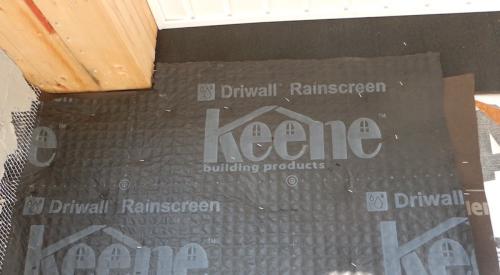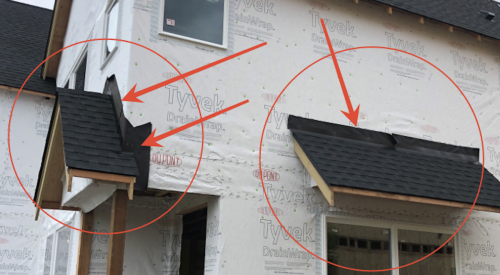Not knowing if there is a problem can be unsettling. Not knowing what caused the problem can add more uncertainty. Even more perplexing can be not knowing for sure what to do to avoid the problem in the future. All of these situations face home builders as they consider one particular siding material: Exterior Insulation Finish Systems (EIFS).
EIFS continues to be a perplexing problem four years after rotting wood walls were discovered in some houses in North Carolina. As awareness spreads across the country about potential problems with EIFS, those uncertainties are what face home builders as they consider the following developments:
- Some builders report no problems with the product, which is also known as synthetic stucco.
- Other builders experience problems.
- Some manufacturers said there should be no problems if the product is installed properly.
- Two manufacturers have stopped producing one kind of EIFS product, the barrier system that does not provide for drainage of water that gets into the walls of a house. The United States Gypsum Co., which is not a member of the EIFS Industry Members Association (EIMA), ceased production of the barrier product in 1995. Senergy resigned from EIMA in September 1998 to concentrate its marketing efforts in the residential market exclusively on EIFS with drainage.
- Building codes in North Carolina and Georgia have banned barrier EIFS. Both states allow drainable EIFS.
- The EIMA board of directors recommended in October 1998 that in one and two family dwellings, EIFS be combined with a means which allows water entering an EIFS assembly to drain.
- The North Carolina Court of Appeals has instructed the trial court in Ruff, et. Al. V. Parex, et al. to permit EIFS manufacturers named as defendants to add claims against home builders, subcontractors, window manufacturers, architects and others.
- EIFS companies formed an alliance with South Carolina architects, general contractors and home builders to formulate a plan to defeat a proposed anti-EIFS bill in the state legislature.
- Ten EIFS manufacturers and four EIFS distributors have been named defendants in a class action suit filed in a Texas state court. The plaintiffs in McCray vs. Parex, et al are seeking compensation for alleged water damage resulting from what they claim are breaches of express and implied warranties, negligence, gross negligence, negligent misrepresentation and fraud by the defendants. Manufacturers named in the suit are Parex, Inc., Sto Corp., Senergy Division of Harris Specialty Chemicals, Dryvit Systems, Finestone, Omega Products, Pleko Systems International, Texas EIFS, W.R. Bonsal Co. and Continental Stucco Products.
- Eight EIFS manufacturers have been named defendants in a class action suit filed in the U.S. District Court in Urbana, Ill.
- In September 1998, a Georgia court denied a motion to certify a class action suit against several EIFS manufacturers by six Georgia residents whose homes allegedly experienced moisture damage.
The most common type of EIFS typically consists of five components: adhesive, insulation board (attached to substrate with the adhesive), a base coat into which a fiberglass mesh is imbedded, and a decorative finish coat in the desired color. This type of system is called a face sealed barrier EIFS. It resists water penetration at its outer surface.
This type of EIFS is not intended to drain water that gets behind it, according to Tom Kenney, a staff member at the Research Center of the National Association of Home Builders (NAHB).
Water infiltration into a home sided with traditional barrier or non-drainable EIFS can cause degradation of underlying materials. Non-drainable EIFS differ from most other sidings, Kenney says, in three ways:
- They do not have a drainage cavity;
- They do not have a weather-resistive barrier (house wrap/tarpaper) behind them;
- They have limited drying potential.
The most frequent source of water intrusion is windows, according to Kenney. Water frequently enters the EIFS, he says, either at the joint around the window perimeter or through seams and joints in the window construction itself. Water intrusion also occurs through and/or around other building components such as doors, gable vents, and a variety of flashing and construction details. Problems, which are usually not visible on the outside surface of a wall, can occur anywhere in the United States with sustained periods of moisture, Kenney notes.
Studies of barrier EIFS conducted from 1995 to 1998 by the National Research Council Canada (NRCC) and USG Corp.found that:
- The barrier EIFS-clad walls were prone to leak when exposed to rainy conditions and readily allowed water to enter into the sheathing and wall cavity.
- The water, while it did not penetrate a barrier EIFS wall with no windows, did leak into walls with windows. Those leaks occurred mainly at wall/window interfaces and through the window assemblies themselves.
Even when the wall construction incorporated sealants such as caulk and backer rod -- as called for by many manufacturers -- water still penetrated and accumulated in the OSB and EPS underneath the windows. In walls that contained an interior vapor retarder, required by building code in many areas of the country, the wall cavity never dried out and lead to extensive rot and deterioration.
- Barrier EIFS allows rain penetration because it does not follow the "rainscreen principle" -- a commonly -- used construction design that provides a secondary line of defense for protection from rain penetration.
The key findings from the research for water-managed EIFS were:
- Water-managed EIFS-clad walls performed effectively and efficiently handled any water that penetrated the systems in tests. The systems had more than adequate capacity to handle water drainage found in a variety of U.S. climates and retained no more moisture than that found in walls of wood or brick-based claddings based on the rainscreen principle.
- Any water that breached the exterior skin was stopped at the building paper and directed down and out of the wall through the flashing and weep details. The water-managed systems worked even when sealants were made to fail completely underneath windows. The EPS below windows in this scenario contained no significant amount of moisture.
- Any moisture that remained in the system was effectively kept from moisture-sensitive materials by the sheathing membrane.
Because of conflicting research and claims surrounding EIFS, builders need to examine closely what is being said by manufacturers and other interested parties. Seminars and information pamphlets have helped some builders become more informed about a problem which doesn't have very many clear-cut answers. Information on the latest industry developments can be obtained on the web site of EIMA, www.EIFSFACTS.com.
EIMA spokesman Stephan Klamke says builders and buyers should consider the following:
- EIFS have compiled an outstanding track record in both residential and commercial construction over the past 30 years.
- Many architects and builders continue to favor EIFS over conventional stucco, brick and other exteriors because of its design flexibility, superior insulation qualities and curb appeal.
- EIFS are an effective deterrent to moisture intrusion if installed according to accepted construction practices, EIFS industry guidelines, and if used in conjunction with code-compliant windows and other critical wall system components.
- What moisture damage there is in EIFS homes tends to be concentrated in wet, coastal areas that have experienced a population explosion in recent years.
- When damage occurs in EIFS homes, it is often limited to a relatively small area of the wall surface. Repairs are usually easy and inexpensive to make, and almost never require removal of the entire EIFS.
- Recently, the EIFS industry, in concert with the NAHB Research Center and the Association of the Wall and Ceiling Industries-International (AWCI), has been developing training and certification programs to qualify home inspectors and contractors to work on EIFS homes.
Builders and consumers continue to seek information about EIFS from EIMA and other sources like the NAHB Research Center, so the topic remains a hot one on the Research Center's Homebase Hotline.The Hotline receives calls daily on EIFS-related problems, according to Kenney.
The majority of early callers experiencing problems were from the East Coast states. However, growing public awareness of problems in other areas of the country has lead to increased call volume from states west of the Mississippi.
Advice to these callers on the hotline starts off with a general caution about choosing any siding material. Research Center staff members then give specific information about EIFS. Kenney says builders of new houses should choose and install any siding or exterior finish carefully. If a barrier or drainable EIFS is chosen, builders need to hire manufacturer-trained installers who use the maker's complete system, he says.
To help builders, the Research Center offers two publications: "Quality Plan for the Installation of EIFS" and "Before You Use EIFS," a pamphlet developed by NAHB that provides a checklist for builders of common questions. The Research Center is also conducting seminars sponsored by some of the EIFS manufacturers. For more information, call the Homebase Hotline at 800/898-2842 or see the web site at www.nahbrc.org.











